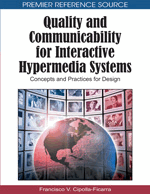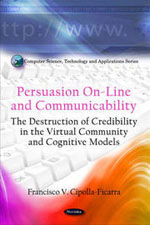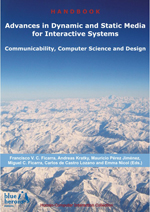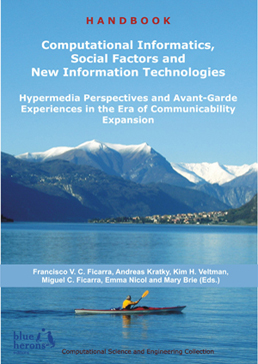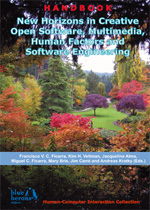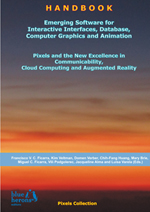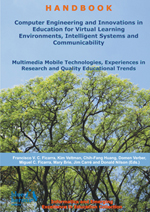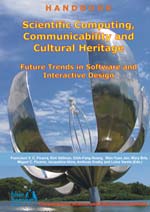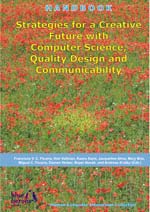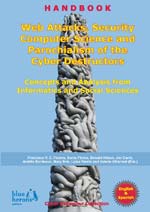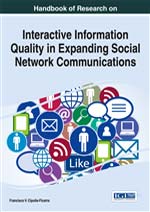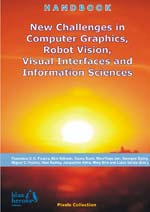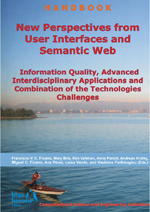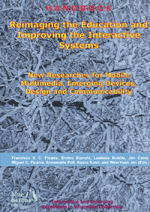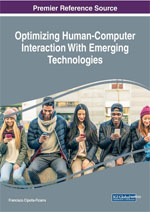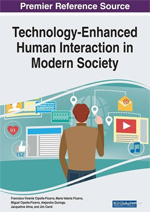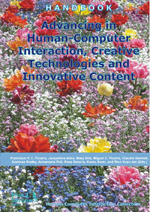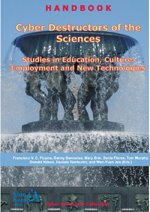Cyber Destructors of the Sciences: Studies in Education, Culture, Employment and New Technologies
:: Cyber Behaviour Collection ::
:: Revised Selected Chapters ::
Main Editor: Francisco V. C. Ficarra
Co-editors: Danny Barrantes (San José, Costa Rica), Mary Brie (La Valletta, Malta), Sonia Flores (Almeria, Spain), Tom Murphy (Dublin, Ireland), Donald Nilson (Oslo, Norway), Daniela Tamburini (Milan, Italy), and Wen-Yuan Jen (Miaoli, Taiwan)
Editorial Assistants: Luisa Varela (Perpignan, France) and Amélie Bordeaux (Lyon, France)
Book Details
• ISBN: 978-88-96471-63-0 :: DOI: 10.978.8896471/630
• Publisher: Blue Herons Editions
• Location: Italy (Bg)
• Subjects: HCI, Computer Science, Audiovisual, Corruption, Cyberbullying, Stalking, ICT, RV
• Subjects: Communicability, Education, University, Software, Hardware, Legislation, Culture
• Subjects: Information, Semiotics, Social Sciences, Employment, New Technologies, R&D
• Subjects: Journals, Publishing Conference Proceedings, Springer Nature, Cyber Terrorism
• Subjects: Aesthetic, Interaction, Design, Orcid, Cross Reference, 'G' Factor, Web, Science
• Subjects: Metaverse, Mimesis, Digital Textbooks, Evaluation, Statistics, Lab., Web 2.0, UX
• Subjects: Robotics, Matching Images, Shape Detection; Key-points, Swarm Algorithm, AR
• Subjects: 4G Technology, Carrier, Linguistics, Hypermedia, History, Digital Identity Card, IT
• Subjects: Ethics, User Identification Algorithm, Cyber Destructors, Parochialism, Garduña
• Copyright: 2017
• Collection: Cyber Behaviour
• Series volume: II
• Publication date: December, 2017
• Binding: Paperback
• Grade level: General
• Language: English
• Illustrations: Yes
• Colour: Yes
• Pages: 242
• Dimensions: 11.41x8.26x0.7 in. 1.71 lbs. :: 290x210x18 mm. 777 gr.
Preface
Never, never, never give up.
Winston Churchill (1874 – 1965)
Actually, the international legislation to tutor the computer users or other devices to receive and send digital information, it is very varied, lax and sometimes ineffective.
The inefficacy is mirrored in an aspect which is not currently taken into account in the legislation for these issues, that is, the speed in detecting, stopping and repairing the damages caused in the face of unfair and unworthy attacks stemming from those cyber destructors directly or indirectly receive orders from the corrupt brotherhood.
In this second handbook of "Cyber Behaviour Collection" we will find the intersection of the formal and factual sciences aimed at education, culture employment and new technologies. We know today the undesirable effects of those behaviours: stalking, harassment, bullying, bossing, etc., through the cyber terrorists of the sciences.
The main goal is to know the latest breakthroughs and the immediate trends, and also in the long term, of each one of the disciplines that make up the sets of the areas of knowledge we approach. Besides, the prevention of the cyber destructors of the sciences into the educational structures, research and development (R&D), job context, social integration, knowledge transfer, etc.
Several of the research works collected in the handbook have been evaluated and corrected prior to publication in an anonymous way by an international scientific committee. In some cases, said studies have been put forward orally (papers, short papers, research-in-progress, posters, etc.), with their corresponding demos, for example, that is, accompanied with practical/theoretical cases in international conferences, workshops and symposiums such as: ADNTIIC (International Conference on Advances in New Technologies, Interactive Interfaces and Communicability), CCGIDIS (International Symposium on Communicability, Computer Graphics and Innovative Design For Interactive Systems), ESIHISE (International Conference on Evolution of the Sciences, Informatics, Human Integration and Scientific Education), HCIHEART (International Conference on Human-Computer Interaction, High Education, Augmented Reality and Technologies), HCITISI (Argentine Conference on Human-Computer Interaction, Telecommunications, Informatics and Scientific Information), HCITOCH (International Workshop on Human-Computer Interaction, Tourism and Cultural Heritage), HIASCIT (International Conference on Horizons for Information Architecture, Security and Cloud Intelligent Technology), MSIVISM (International Conference on Multimedia, Scientific Information and Visualization for Information Systems and Metrics), RDINIDR (International Conference on Research and Development in Imaging, Nanotechnology, Industrial Design and Robotics), and SETECEC (International Conference on Software and Emerging Technologies for Education, Culture, Entertainment, and Commerce). In the next section a short introductory presentation of the chapters that make up the current book is given:
With the title of “Partners' or Cyber Terrorists of the Publishing Scientific Research in Journals, Publishing Conference Proceedings and Books?” a set of evaluations and their corresponding results are presented to demonstrate the existence of the loss of reliability in the scientific publications, through the denominated “G” factor. Today, with epicenter in Springer Nature –Publishing conference proceedings, in computer science editorial + Business Media HCI group. In the chapter, several cases of real studies are presented, where it is feasible to demonstrate, not only the destructive power from the relations between power groups, influencers, cyber destroyers, corrupt university teachers, etc., but also, the absolute European legal immunity prevailing in the new millennium. These real cases have been analyzed through heuristic evaluation techniques and methods, some of them from the social sciences and software engineering. Relationships that demonstrate how current mechanisms and people for the evaluation of scientific and educational quality (linked data initiatives, open data in education, orcid peer review, open citations, cross reference working group, web science, etc.) in countless universities, foundations, organizations, etc., within and without the borders of the European Union, are equal to zero. Simultaneously, the mechanisms of indexing scientific works, the use of identifiers of the scientists and their works (for example, those promoted from the Springer publishing house, computer science area) are explained in detail, only respond to wild marketing without scientific value, that is, with a reliability equal to zero, too. Finally, there are examples where researchers, teachers, students, scholarship holders, etc., are working directly or indirectly free of charge for the pseudo executives and controllers of global publications, in private publishing firms, such as some with headquarters in Germany or Switzerland or Moscow (Springer Nature –computer science area), with ramifications of computer specialization, in others countries.
Iulia Lazar and Ion-Ovidiu Panisoara are the authors of a study related to education and ICTs, who have decided to name it “The Role of New Generation of Digital Textbooks and the European Standards in the Environmental Science Education.” In said study, parallels are established between traditional and current educational processes, through the use of new technologies. Avant-garde technological instruments that facilitate the learning process of students, such as digital textbooks. Through them, the authors indicate the potentialities in the process of intergroup interaction, as well as individual. Consequently, one of the main central objectives of the chapter is to present the role of digital textbooks fulfilling the European Union standards designed to be an adaptive educational resource for environmental science, providing the premises for improving the quality of education. In other words, Iulia Lazar and Ion-Ovidiu Panisoara are assessing the aptitude for science of pre-university students, taking into account the parameters of the European average. Each of the sections of the chapter is accompanied by tables and figures that facilitate the didactic comprehension and the breadth of the work carried out. Some of these sections are: What is a digital textbook?; What is a digital native?; The current state of knowledge in the field of digital textbooks; The advantages of using digital textbooks; Existing barriers to the design and implementation of digital textbooks; Integrated Environmental Science Education; A Quality Assessment Guide; Lesson plan to teach science using digital textbooks; An example from Natural Science Domain, among others.
The research work “Ethics and Aesthetic Quality thought eLearning Platforms: A Case Study Research in Speech Therapy” has been developed by Iuliana Lazar, Georgeta Panisoara, Alex Malureanu, Cristina Sandu, and Gabriel Lazar. In it, the authors indicate the importance of the notion of ethics, as well as the use of ethics and aesthetics of an online platform used in speech therapy. The present study denotes an important investigation in the state-of-the-art, beginning by the search of research works that are related to the treated subjects, as can be the data coming from the statistics, for example. That is, it is a multidisciplinary research in the field of Information Technology (IT), ranging from the aesthetics of interfaces, for example, to experiences with users, or from intellectual property aspects to the realization of a learning environment for a speech therapy product. The breadth and precision of the topics dealt with, as well as the results obtained, has allowed the authors to develop guidelines. The purpose of the synthesized landmarks related to informed consent and the set of guidelines is to suggest the highest ethical standards in research. Also, these guidelines can be used as a shared source of usually accepted practice for qualified researchers and as a coordination to those beginning research professions. In short, it is a multidisciplinary work in which several areas of knowledge are related to education and new technologies, and have a wide area of intersections.
The author of the chapter “The Universe and the Multiverse: From Matching to Cross-Matching” is Kim H. Veltman. It is a research that allows us to investigate the past, present and future of static and dynamic images, from both a historical and a futuristic perspective. In this examination the author indicates a special interest with reference to the consequences for future interfaces. Although, a priori, certain critical aspects can be perceived before the new ICT devices, especially those aimed at the interactive communication systems, however, it is the opposite. That is, Veltman ponders the use of these new technologies but under a renovating vision, starting from history. “We need new forms of reality and truth meters”, remarks and advises the author. There are some useful tips and particularly oriented to developers of software, hardware, interactive contents, etc., but as in a myriad of examples or real cases, they are conspicuous by their absence, all over the world. The following sections stand out in the structure of the work: Connecting, Ordering and Imitation (Mimesis); Matching; Mixing and Exploring; New Trends in Philosophy; Cross-Matching; Social Social Media; Universe versus Metaverse; New Tools; Future Developments, among others. Each of these sections is accompanied by illustrations that are introduced and explained extensively and exceptionally in the text. In the references section, the reader who is interested in the contents of the chapter can find additional sources of information.
The research work with the title of “Image Processing Techniques in Vision-based Robot Navigation” has three authors: Rodrigo Munguia, Yolanda Bolea and Antoni Grau. They have been inspired for the present proposal in solving the problems of vision-based mobile robot map building and localization. Consequently, they present throughout the chapter a comparative study of statistical methods for matching images in a wide base line between learning and recognition phases. Following these ideas, the two authors propose a general methodology called feature-class method for the problem of fast matching image features in a wide base line described in the context of mobile robots. In addition, they have generated a set of statistical methods, which are not only presented in the chapter, but also compared to each other. Rodrigo Munguia, Yolanda Bolea and Antoni Grau indicate that it is important to note that the use of the methods and strategies studied in this research work would not be enough, by themselves, to obtain a match set of a sufficient quality to be suitable for most computer vision applications. Instead, they have to be used within a more elaborated matching scheme. In short, the main objective of this research work is therefore to give a good idea of the performance of the methods among them and the effectiveness of the methodology, not to study these algorithms as a whole, as the authors conclude. An excellent didactic style predominates in the text, and the main sections of the work are: Feature-class methods as a general methodology; Statistical methods for matching features in a wide base-line; and Experiments. These sections allow the readers to have a global vision of the developed research.
With the title of “Shape Detection based on Analysis of Key Points” their authors Dawid Połap, Marcin Woźniak, and Robertas Damaševičius present a research centered on the following major topics: Shape detection; Key-points, and Swarm algorithm. From the beginning of the chapter, its authors point out the importance of images for the detection of objects, applied in several strategic and highly topical sectors. They also highlight how the constant evolution of new technologies and research are developing methods to improve the accuracy to locate objectives, without major complications and with limited financial budgets. Throughout the text, Dawid Połap, Marcin Woźniak, and Robertas Damaševičius present not only images in this regard, but also a series of tests where the transcendence can be verified in detection support in image processing systems. There are several results in this regard, particularly on swarm algorithm with filtering developed to detect objects in 2D images. Simultaneously, and with a high pedagogical level, the authors present each of the aspects related to the present investigation, accompanied by photographs, diagrams, tables, etc. Finally, through the results obtained from the experiments, it can be verified and demonstrated how the proposed method is efficient, since the results could be verified by the proposed solution.
In the chapter “Operations of Unions and Intersections for the Destruction of the First Human-Computer Interaction Lab in Barcelona” for the first time, the destructive operations of Catalan synergy and Basque collaboration stemming from pseudo ultra nationalism, camouflaged neo-Nazism, political corruption, savage mercantilism in education and religious tricks, among other sadistic scam schemes are presented. The author in the present work uses a novel technique to relate true facts in the context of computer science, in particular, in the Iberian context of the Human-Computer Interaction. The texts are accompanied by real documents. In the chapter, it describes and verifies how the negative human factors that point to new technologies can not be stopped in any way, inside and outside Catalonia. That inaction of the local scientific society, with its national and international ramifications, together with the non-existent application of legality to the members of the Garduña, will end up destroying not only the fundamental principles of the sciences, but also the educational, productive and commercial system applied to computing and the rest of the disciplines that it includes. Finally, some annexes with examples of the new millennium are presented, where the perennial destruction from the Garduña is verified, to eliminate an honest and modest genesis, within the context of the HCI in Barcelona, which continues to exist and resisting for a quarter of a century, to the “G” factor.
The authors of the chapter “Long Term Evolution” are Daniel Biga, Fernando Dufour, Ariel Serra, Carlos Peliza, and Gustavo Micieli. It is a research that has as its central axis telecommunications, specifically, long term evolution, 4G technology, carrier aggregation, among others. In the present work there is a special attention to the mobile networks sector, reason why its authors summarize in a concise and precise way the main characteristics of the 4G technology. Towards that goal, in the study carried out by Daniel Biga, Fernando Dufour, Ariel Serra, Carlos Peliza, amd Gustavo Micieli, a special focus can be observed, in what they consider to be a radical change in the context of telecommunications, that is, when the time comes to offer to the local users , of the networks a higher speed of data transmission for customers, which is the aggregation of Radio Frequency Carriers for the same client (Carrier Aggregation). Based on the studies conducted, the authors predict that a smartphone connects to the band which seems to be the best possible connection. In the chapter you can see a perfect academic level given the complexity of the issues that are addressed but that complexity is diluted by the schemes, charts, tables, etc. which have ben correctly introduced by their authors for all potential readers. Finally, in the last sections, that is to say, the lessons learned, conclusions and future research, there is a kind of compass for all those interested in investigating the theme developed.
Under the title “Hobby-consistency based User Identification Algorithm (HUIAS) Across Sites”, its authors Meiling Ren, Ruichun Tang, Kepeng Sun, Jian Wang, Lulu Xue present us with a new algorithm to address the cross-media user identification problem through extensive studies on user analysis and data mining. The structure of the interesting proposal can be stratified or summarized in the following way, as if they were stages: First, user's complementary information in different sites is integrated and all the users in two sites are combined to user pairs each from different sites; second, a traversal function is used to find out user pairs' numbers of common friends in descending order; third, user pairs' hobby consistency is computed using a similarity function on a hobby quantification method, and finally, the cross-media users are identified through the hobby consistency calculated above. The robustness of the work developed is reflected in the results that the authors have obtained at the time of performing the simulations. Through them, it can be confirmed that the present proposal is efficient. Now, a simple way to summarize the most important sections of this chapter is the following: Model abstraction and problem analysis; Related concepts; The HUIAS algorithm; and Experimental results. Through these sections, the reader can understand the validity and scope of the work developed by the five authors.
In the work called “Rules for a Heuristic Assessment of the Cyber Destructors: Linguistics and Semiotics Strategies” their authors, Francisco V. C. Ficarra and Donald Nilson present a first set of instruments to evaluate and detect potential cyber destroyers. These evaluation instruments come basically from the social sciences. A first group of linguistic and semiotic strategies are applied for the analysis of online messages, social networks, etc. The discourse analysis of the cyber destroyers is examined in detail, in order to establish categories of destruction, psychological profile, and prevent their harmful actions in virtual contexts (social networks), and/or in real life, such as work or the social interrelations. The universe of study is composed of young pseudospecialists in human-computer interaction, stalkers in social networks related to scientific communication and computer science, the holding of international conferences in the area of new technologies, the publication of the proceedings pertaining to the field of information technology, whether in proceedings and/or book format, etc. Finally, a set of words and phrases that detect the presence of bipolar teachers, students, etc. are established. among other psychological and/or psychiatrist deviations.
Francisco V. C. Ficarra presents in “Hypermedia Information Retrieval: A Spanish Study”, a virtual tour through the history of Spanish hypermedia systems that have marked a historical milestone in the '90s, whether from the interactive design, the originality of the content, the creativity in the interface, the robustness in the structure for accessing the information stored in the hyperbase, the ease of navigation, among other design categories, quality attributes, etc. At the same time, he relates for the first time how the media of the specialized press were influenced by the opinions of the heads of audiovisual institutes, industrial schools, architecture and telecommunications schools, etc., in Barcelona, Valencia, Madrid, Mallorca, Bilbao, Zaragoza, etc. In parallel, the author discloses some of the criteria that predominated when evaluating them in paper magazines, belonging to the specialized press as a whole, especially in the multimedia, computer, software, hardware, videogames, etc. sectors. Also, he presents the strategies followed by some university centers to obtain prizes awarded in advance, for projects that were carried out outside the teaching centers or with personnel hired externally to the universities. Finally, current links are established between past and presente, in the context of the Human-Computer Interaction.
In the research called “Digital Identity Card versus ‘Papyrus’ Systems”, the author performs a heuristic and diachronic analysis of the current systems of digital and analogical identification of the European people, where it shows the existence of paper support in the second decade of the new millennium. The study focuses on the various existing digital systems to identify the population, especially those related to graphic computing and/or its derivations, as opposed to the use of archaic systems for certain sectors of the population in the European Union. Also, the first results obtained between systems of the American and European continent are presented. The phenomenon of social and labor integration is also studied according to the different types of Digital Identity Card. The study begins with a sociological, educational and labor perspective, in the field of ICTs and all its derivations. Contemporaneously, the mechanisms of social exclusion, and the individual and/or family consequences are analyzed, especially those cases in which the inhabitants have one or more university degrees. Finally, Ficarra examine whether these mechanisms of social and labor exclusion have diminished or increased over time.
Francisco V. C. Ficarra
El Hierro, Spain (December 2017)
Partial Content On-line (pdf format)
• Front Cover (here)
• Preface :: Acknowledgment (here)
• Chapters :: Final Remarks :: Author Index :: Keywords Index :: References ... (here)
• Back Cover (here)
Additonal Handook Info
• Only paper copy – no digital book on-line and/or off-line –
• Special Price € 95 (expedition cost not included) ... e-Commerce :: Info Form
Welcome to Blue Herons Editions!
The origin of this publishing project is to be found in the Canadian lands, where nature presents itself generous in many places of its wide geography. More...
Education, Communicability, Design, Computer Science, HCI, Computer Graphics and Computer Animation:
We focus on education and new technologies with 37 years long experience. More...
Literature and Journalism:
Intersection between universal literature, local new journalism (true stories), sociology and legal immunity. Two collections:
- Casoncelli Bergamaschi
It is a typical bergamasque dough filled with meat, similar to the raviolis. More...
- Menjar Blanc & Black
It is a typical sweet of the Catalan coast and the Balearic Islands. More...
Others Releases:
See all others new releases in books, CD, DVD, etc. More ...

Call for Papers, Short Papers, Posters, Demos, Research-in-Progress, Workshops, Doctoral Consortium, Hardware & Software Companies - Didactic Demos Sessions ...
ADNTIIC 2018 :: HCITOCH 2019 :: SETECEC 2019 :: HIASCIT 2019 :: CCGIDIS 2019 :: IPCTIIC 2018 | HCITISI 2018 :: MSIVISM 2019 :: RDINIDR 2018 :: ESIHISE 2018 :: HCIHEART 2019 :: QUITANS 2019


